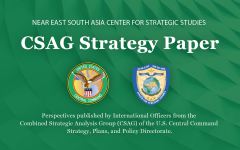The Hamas – Israel Conflict: Forming A Potential “New Normal”
February 2, 2024 2024-02-02 11:29The Hamas – Israel Conflict: Forming A Potential “New Normal”
The Hamas – Israel Conflict: Forming A Potential “New Normal”
CSAG STRATEGY PAPER
By: LTC Kashif Ehtisham, Pakistan Army (CSAG/CCJ5);CDR Hubert Mroz, Poland Navy (CSAG/CCJ5); and MAJ Ibrahim Elveren, Turkish Army (CSAG/CCJ5)
29 January 2024
Overview:
The Hamas attack on Israel on 7 October has affected not only the political and security dynamics in the ME region but also the world at large. This attack being executed simultaneously in multiple domains i.e. air, land, and sea, culminating with ‘mass hostage captivity’, can be regarded as unprecedented due to its complexity, scale, and outcome. The resultant bloody conflict, which has been continuing for more than three months, has disrupted the entire region and threatens to escalate. Dismay over what many perceive as a disproportionate Israeli response has without question brought suffering to the majority of Gazans. Activities of the Iranian Threat Network (ITN) using the plight of Palestinians as a pretext to further violence, especially the Houthi attacks on merchant ships disrupting the sea lines of communication (SLOC), threatens the stability of the region.
While many actors in the region were navigating paths towards normalization of relations, the Hamas-Israel conflict altered the existing security paradigm. This may yet challenge US efforts in deterring Iran and countering VEOs. Implications remain fluid and may alter the ME integrated frameworks that had been established for greater stability.
The Hamas-Israel conflict could be the litmus test for the US grand ‘National Security Strategy’. The US support for Israel’s security and recent build-up in the region may also impact Strategic Competition, specifically in the CENTCOM AOR.
Key Points:
- The Hamas-Israel conflict has reshaped the ME security landscape, posing potential challenges to stabilizing relations, deterring Iran/ITN, and countering VEOs.
- The Hamas-Israel conflict could be the litmus test for the US grand ‘National Security Strategy’. The US support for Israel’s security and recent build-up in the region may also impact Strategic Competition, specifically in the CENTCOM AOR.
- Amongst the ITN, Houthis are trying to increase their power and legitimacy by using the plight of Palestinians caught up in the conflict as a pretext for attacking the SLOC’s.
- While differing from ISIS, Hamas also thrives on an ideology that, if not addressed effectively in the moral and conceptual domains, cannot entirely be eradicated in the physical domain.
- China (with other actors) is taking advantage of the US’s unequivocal support for Israel, disregarding Palestinian security, to infer an equal but opposite anti-US narrative.
- Resurgence of dormant conflicts, exemplified by the resumption of attacks by IAMG (Iranian aligned militia groups) in Syria and Iraq, poses additional challenges, potentially amplifying the overall regional instability.
- Israel’s approach could be counterproductive; continuation of aggression will not eliminate Hamas.
- Incoherent US actions in the region can create dissent, which may damage partnerships to adversaries’ advantage; a potential “New Normal”.
View other USCENTCOM Combined Strategic Analysis Group (CSAG) papers here.
The opinions and conclusions expressed herein are those of a number of international officers within the Combined Strategic Analysis Group (CSAG) and do not necessarily reflect the views of United States Central Command, not of the nations represented within the CSAG or any other governmental agency.







